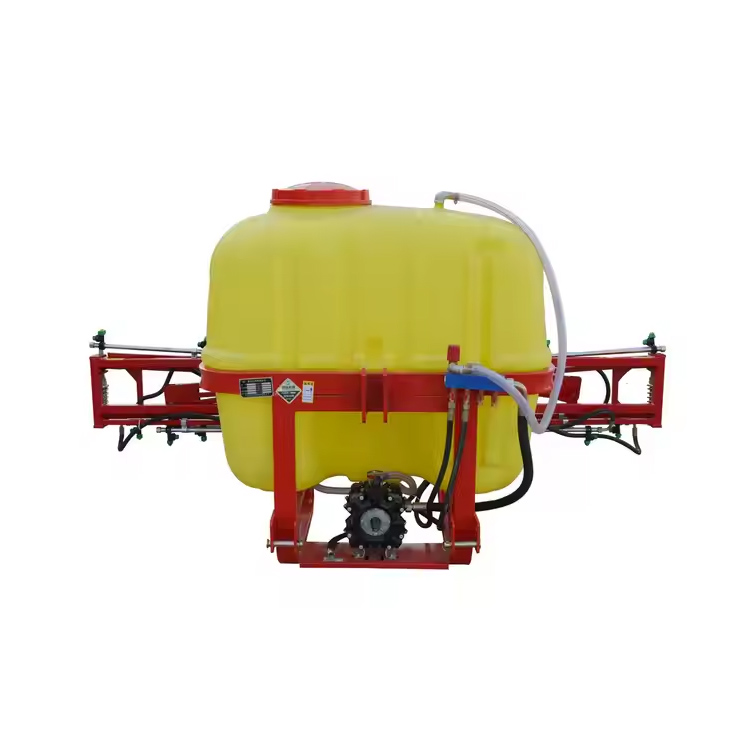Boom Sprayer: A Game-Changer in Agricultural Spraying Technology
2025-02-19
In modern agriculture, efficiency, precision, and productivity are key to successful crop management. One of the tools that has significantly revolutionized the way farmers apply pesticides, herbicides, and fertilizers is the boom sprayer. Designed to cover large fields quickly and evenly, boom sprayers offer unparalleled efficiency in spraying large-scale crops, ensuring that nutrients and chemicals are applied accurately and consistently.
What is a Boom Sprayer?
A boom sprayer is a piece of agricultural equipment designed for applying liquid chemicals (like fertilizers, herbicides, pesticides, and fungicides) to crops. It consists of a long boom (usually several meters in length) with spray nozzles mounted along its length. The boom is mounted on a vehicle, typically a tractor or a self-propelled sprayer, allowing the sprayer to cover wide swaths of crops in a short period.
Boom sprayers are commonly used in field crops, vineyards, and orchards, where precision in applying treatments to large areas is essential. The boom allows for uniform distribution of chemicals, reducing waste and ensuring that all areas receive adequate coverage.

Key Components of a Boom Sprayer
1. Boom Assembly
- The boom is the horizontal frame that holds the spray nozzles. It can be folded for easy storage and transport and is adjustable in height to adapt to different crop types.
2. Spray Nozzles
- Nozzles are mounted along the boom to distribute the liquid spray over the crops. They come in various types, such as flat-fan nozzles for even coverage, or air induction nozzles for improved drift control.
3. Tank
- The tank is where the chemicals are stored before being sprayed. Tanks come in various sizes depending on the sprayer’s design and the area to be covered.
4. Pump
- A pump pressurizes the liquid in the tank, forcing it through the pipes and out of the nozzles. The pump’s capacity dictates the sprayer’s ability to maintain consistent pressure across the nozzles.
5. Control System
- Modern boom sprayers feature advanced control systems that help operators monitor and adjust the spraying process. These systems may include GPS technology for precise application, automatic pressure regulation, and nozzle modulation.
Advantages of Using a Boom Sprayer
1. Efficiency and Speed
- Boom sprayers allow farmers to cover large areas quickly, reducing the time and labor needed compared to handheld sprayers or smaller equipment. This efficiency is especially important for large-scale farms.
2. Even Coverage
- The boom’s design and adjustable nozzles ensure that the chemicals are applied evenly across the field, which helps in achieving uniform crop treatment and optimal results. This minimizes the risk of over-spraying or under-spraying certain areas.
3. Cost-Effective
- By covering larger areas in less time, boom sprayers can reduce the overall labor costs and fuel expenses associated with manual spraying methods. Additionally, their precise application reduces chemical waste and runoff, saving money on inputs.
4. Reduced Chemical Waste
- Boom sprayers are designed to minimize drift, ensuring that the chemical applications are precise and targeted, which helps reduce wastage and environmental impact.
5. Customizable for Different Needs
- Boom sprayers can be equipped with a variety of nozzles, pumps, and controllers to cater to different spraying needs. Whether it’s a fine mist for herbicide application or a heavier spray for fungicides, boom sprayers can be adapted to suit specific requirements.
Types of Boom Sprayers
1. Tractor-Mounted Boom Sprayers
- These sprayers are attached to the back of a tractor and are commonly used in large field operations. They are often designed for high-capacity tanks and can cover several acres at once.
2. Self-Propelled Boom Sprayers
- Self-propelled boom sprayers are autonomous vehicles equipped with booms, tanks, and control systems. They offer high maneuverability and are ideal for large operations where speed and efficiency are critical.
3. Tow-Behind Boom Sprayers
- These sprayers are towed by a tractor or other vehicles and are typically used for medium to large-scale applications. They are easy to use and cost-effective, making them popular for farms of varying sizes.
Common Applications of Boom Sprayers
1. Crop Protection
- Boom sprayers are primarily used for applying pesticides, herbicides, and fungicides to protect crops from pests, weeds, and diseases. The precision of the boom sprayer ensures that the treatment is applied to the targeted areas of the crops, ensuring effective pest control.
2. Fertilizer Application
- Boom sprayers are also used for applying fertilizers to fields. The even distribution of fertilizer promotes healthier crops, improves yield, and ensures optimal growth conditions.
3. Irrigation
- Some boom sprayers are equipped with irrigation systems to apply water to crops, especially in areas where water management is critical. These systems can be adjusted for optimal water delivery and evaporation control.
Choosing the Right Boom Sprayer
When selecting a boom sprayer for your farm, consider the following factors:
1. Farm Size
- Larger farms require sprayers with larger tanks and booms to cover more ground quickly, whereas smaller operations might need more compact models.
2. Field Terrain
- Choose a sprayer that is suitable for your field conditions. If you have uneven terrain, a self-propelled sprayer with better maneuverability might be a good choice. For flat, open fields, a tractor-mounted sprayer can be more efficient.
3. Chemical Compatibility
- Ensure that the sprayer is compatible with the chemicals you plan to use. Some sprayers are designed for specific applications (e.g., pesticide vs. fertilizer) and may feature special nozzles or pumps to handle different liquids.
4. Maintenance and Durability
- Consider the sprayer’s build quality and maintenance needs. Equipment used in agricultural spraying can face harsh conditions, so durability is important for long-term performance.
Boom sprayers have become an indispensable tool in modern agriculture. Their ability to deliver efficient, even coverage for pesticides, herbicides, and fertilizers ensures that crops are treated effectively while minimizing chemical waste. Whether you are managing a small farm or overseeing a large-scale agricultural operation, investing in a boom sprayer can greatly enhance productivity, reduce labor costs, and improve the overall health and yield of your crops. With the right boom sprayer, you can ensure that your agricultural practices are both cost-effective and environmentally responsible.


